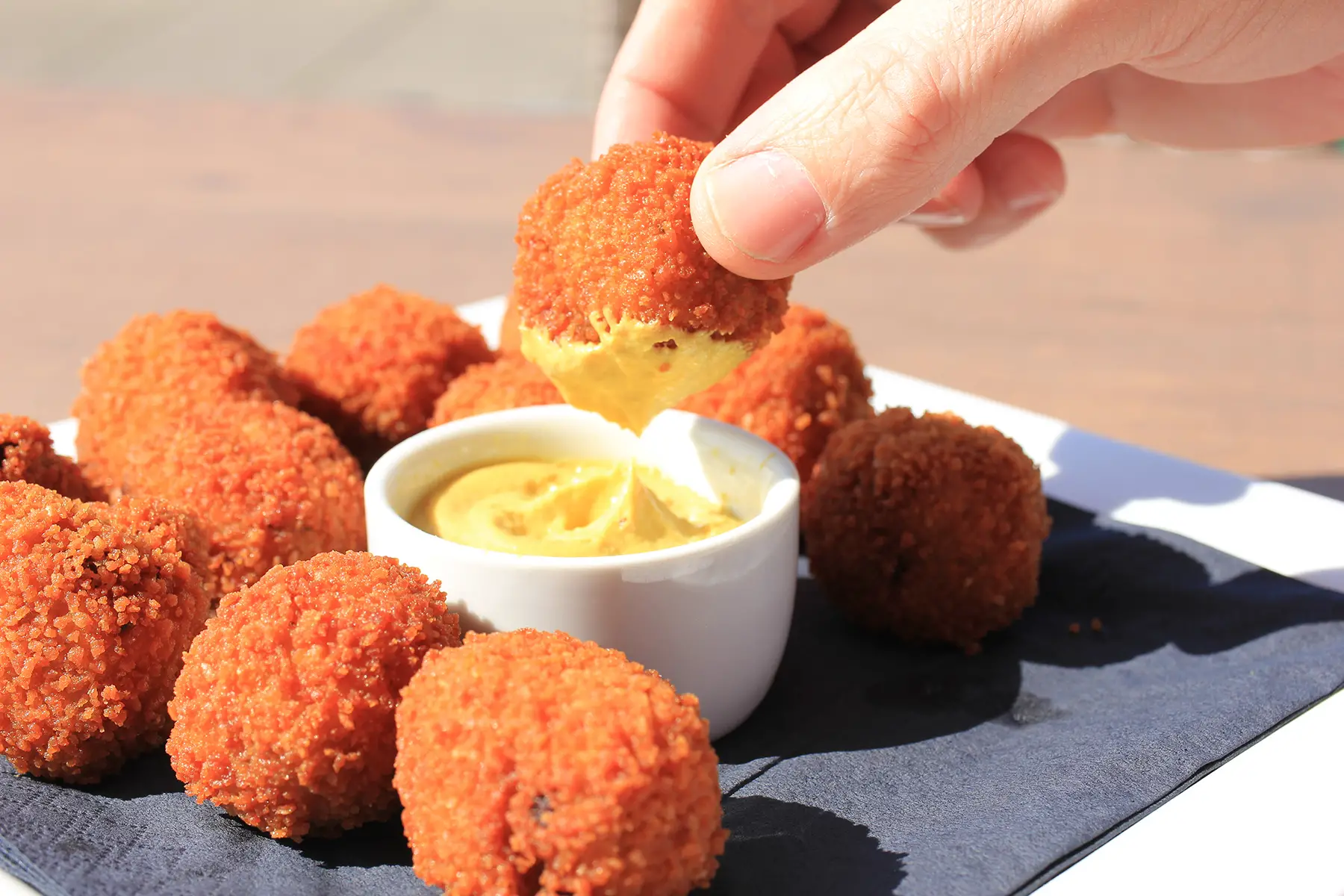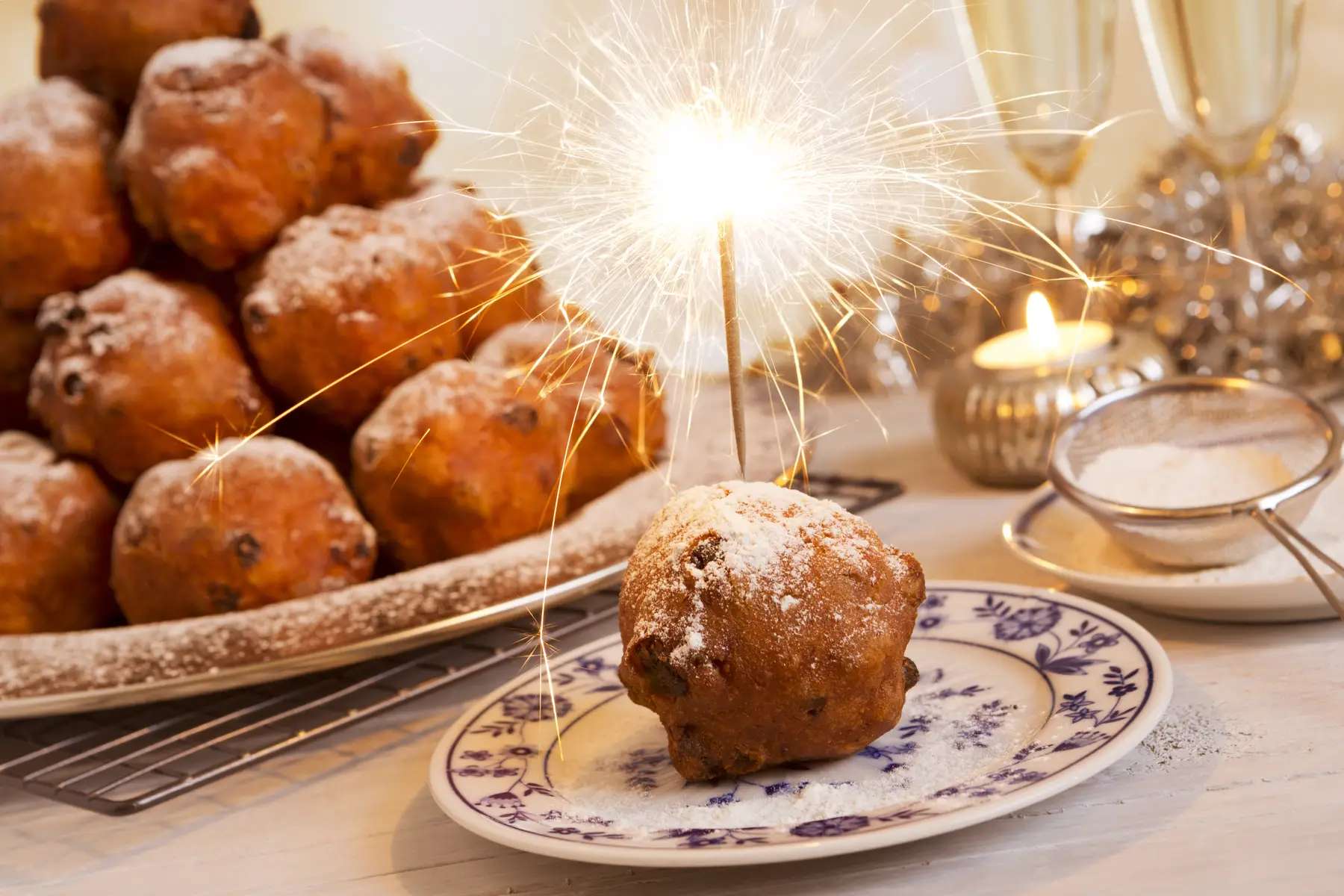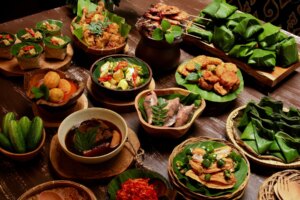The Netherlands is home to some incredible snacks that range from sweet and comforting to tangy, salty, and bold. From the syrupy indulgence of stroopwafels to the briny kick of pickled herring, each of these iconic Dutch snacks will tickle your flavor palate.
Ready to dive in? Continue reading to explore the best the Dutch have to offer (snack-wise, anyway):
Flink
Empty cupboards but no time to go shopping? Flink offers all your favorite supermarket products at supermarket prices, delivered directly to your door. Whatever you need – food items, toiletries, or stationery, get it delivered in minutes with Flink.
The best umami Dutch snacks
Bitterballen and kroketten
Bitterballen are the undisputed champions of Dutch snacks, and it’s easy to see why. Crispy on the outside and irresistibly creamy on the inside, these deep-fried meatballs filled with a savory ragout are the ultimate companion to any alcoholic drink.
Bitterballen are typically made with beef, veal, shrimp, or – for the vegetarians – beetroots, chickpeas, or mushrooms, and served with a dollop of grainy mustard. But be careful when you take that first bite: these little devils are lava-hot on the inside: always proceed with caution.

Their cylindrical cousin, the kroket, offers the same glorious taste but in a longer shape. This popular snack is available in many bars, cafés, bistros, and restaurants throughout the Netherlands, including the legendary vending machine snack wall. Kroketten are often enjoyed on their own or tucked into a slice of white bread, whichever you prefer.
Haring met uitjes
Few Dutch snacks divide opinion more than this fishy delicacy: haring met uitjes. But hate it or love it, everyone will agree that this raw herring is an institution in the Netherlands. They’re sweet and tangy and – when served with chopped raw onions – offer the perfect umami bite.
The fish is at its prime between May and July, which is when the best catches (Hollandse nieuwe) are available. It typically comes on a plate or in a soft bun (broodje haring), but for the full experience, you’ve to eat it the classic Dutch way: hold it by the tail, tilt your head back, and chomp chomp chomp your way down to enjoy.
The Dutch love for herring runs so deep that it’s celebrated annually at Vlaggetjesdag (Flag Day). During the festival, fishing boats wave flags, and women in traditional dress welcome the return of the herring fleet and feast on the new season’s catch.
HEMA worst
The HEMA doesn’t pay us, their HEMA worst is just that good. This smoked sausage is a true Dutch icon, loved for its simplicity and hearty flavor. With its juicy, savory filling and slightly smoky aroma, it’s a comforting treat that’s perfect for a quick bite or a delicious stamppot sidedish.
The HEMA worst is served warm and with a dollop of mustard. While some people choose to eat it in a bread roll (and the company seems to push it like that these days), it’s best eaten straight uit het vuistje.

And just to prove we aren’t lying: the Dutch love for HEMA worst was put to the test in 2007 when a disgruntled employee revealed that Unox was actually behind the famous sausage. While the leak sparked outrage, it was directed at the former employee and not at the sausage. As a nation, the Dutch went, “Yes, we know. Stfu and let us enjoy our worst.” And no one has ever talked about it since.
Oude kaas
A timeless classic that is aged for at least a year, oude kaas (old cheese) is known for its deep, rich flavor. Indeed, this cheese packs a punch with its nutty, caramelized flavor and a sharp, tangy finish. The firm, crumbly texture – complete with those irresistible cheese crystals – is a hallmark of its careful aging process.
Whether you’re pairing it with a beer or wine or just eating it straight from the block (no judgment), oude kaas is a favorite for those who appreciate bold, well-rounded flavors. Found in markets and stores across the country, oude kaas is bold, rich, and unapologetically Dutch (don’t tell the Italians, who may have introduced the cheese to the Netherlands).
Which sweet Dutch snacks must you try?
Oliebollen
Every New Year’s Eve, the Dutch party table have a plate filled with Oliebollen. Indeed, they are the ultimate Dutch winter treat; olden, deep-fried dough balls that are fluffy on the inside, crisp on the outside, and topped with powdered sugar for the perfect indulgent bite.
Found at street stalls across the Netherlands during the holiday season, oliebollen are a highlight of Oud en Nieuw. Whether plain or filled with raisins, they’re best enjoyed warm, paired with champagne or whatever it is that kids drink instead of that.

Poffertjes
Poffertjes are the epitome of simple Dutch comfort food. These fluffy, coin-sized pancakes are made from buckwheat flour and yeast, which gives them a light, airy texture. Served warm with a pat of butter and a generous dusting of powdered sugar, they practically melt in your mouth, striking the perfect balance between sweet and satisfying.
Poffertjes are a staple of Dutch street food, often enjoyed at outdoor markets and festive events. Indeed, they’re quick to whip up, easy to share, and impossible to eat just one of.
Stroopwafels
For the ultimate Dutch snack, anyone with a sweet tooth has to try Stroopwafels. These are two thin wafers sandwiched together with a layer of warm, caramel-like syrup – the perfect combination of crunch and chew.
Widely available at markets and bakeries across the Netherlands, they’re ideal for enjoying on the go or savoring slowly over a hot cup of coffee or tea.
Traditionally, you have to balance the stroopwafel on top of the mug, allowing the steam to soften the syrup and create an indulgent bite every time. Simple yet irresistible, once you try them, you’ll wonder how you ever lived without them.
Tompouce
Based on the French millefeuille, the tompouce is a classic Dutch pastry that is as delightful to look at as it is to eat. This rectangular treat consists of two layers of crisp, flaky puff pastry filled with a thick, creamy custard and topped with a glossy pink – or sometimes orange – icing.
It’s famously tricky to eat without making a mess, but that’s part of the fun. The tompouce is a staple during special celebrations, such as King’s Day.
What Dutch snacks are sour in flavor?
Amsterdamse uitjes
Amsterdamse uitjes, or Amsterdam onions, are a classic Dutch snack staple, loved for their unique combination of sharpness and sweetness. These small pickled onions are soaked in bright yellow, turmeric-infused vinegar, giving them their distinctive yellow hue and sweet-and-sour flavor.
With a crisp texture and a tangy kick, Amsterdamse uitjes are the perfect accompaniment to rich and savory dishes and a must-try for anyone exploring Dutch culinary traditions.

Zure matten
If you want to wake up your taste buds with something truly sour, you have to try Zure matten, because this Dutch candy will deliver a mouth-puckering sourness with a hint of sweetness.
These colorful, flat strips of chewy candy are coated in a fine layer of sugary, sour dust, and are available in a rainbow of flavors like apple and strawberry. Simple, bright, and irresistibly tart, they’re a nostalgic treat for children and adults alike.
Rolmops
If you are feeling adventurous, rolmops (rollmops) are a quintessential Dutch snack that brings a burst of briny, tangy flavor to the table.
These rolled fillets of pickled herring are wrapped around a gherkin and served with chopped onions. With the taste of the sea and a refreshing kick of acidity, rollmops pair beautifully with fresh bread or a crisp beer.
This unique snack is typically served to the older Dutch generation, with many young people flat-out refusing to go near it. Also, maybe don’t tell the Germans that we claim it as our own.
What are the best salty Dutch snacks?
Kapsalon
Now, here’s a snack that’s truly unapologetically Dutch. Sure, French fries are a popular snack throughout the world, but if you’re craving bolder flavors, you have to try a kapsalon.
Invented in Rotterdam, this dish is hearty, messy, and utterly satisfying. The kapsalon has a base of crispy fries loaded with juicy döner or shawarma meat, melted cheese, and fresh salad. The whole dish is finished with a generous drizzle of garlic sauce and hot sauce for a perfect mix of creamy and spicy.
Loved for its over-the-top combination of flavors and textures, the kapsalon is a Dutch snack indulgence you’ll want to have tried yesterday.

Zoute drop
Adored by locals and hated by newcomers, zoute drop is a staple in Dutch snack culture. Firm and chewy, these salty licorice candies come in a variety of shapes, textures, and levels of saltiness.
Their bold, salty kick divides opinions like few other snacks. Whether they love it or hate it, many Dutch people view this as a nostalgic snack that’s perfect for nibbling on the go or sharing during long car rides.
Some of the bitter Dutch snacks
Jenever bonbon
Jenever bonbonnen are a modern twist on the traditional liquor bonbons. These bite-sized treats combine the rich decadence of chocolate with the iconic flavor of Dutch jenever. The result is a perfectly balanced confection: sweet and creamy on the outside, with a warm and bitter kick on the inside.
While not yet widely available, jenever bonbons celebrate the Netherlands’ rich distilling heritage in a delectable form.
Taai taai
Taai taai is a classic Dutch snack for those who appreciate its subtly sweet, slightly bitter flavor. Made with rye flour and a mix of hearty spices like anise and cinnamon, this chewy cookie has a firm yet pliable texture – earning its name, which loosely translates to “tough tough.”
Taai Taai is traditionally shaped into festive figures and enjoyed during Sinterklaas. But, because it pairs perfectly with a hot cup of coffee or tea, this cookie is also a comforting treat on chilly days.
Other snacks you have to try
The Netherlands has so many other Dutch snacks that can answer whatever craving you may have, including:
- Bosche bol – a giant cream puff covered in chocolate
- Frikandel – a deep-fried sausage and one of the most popular snacks in the Netherlands. Popular variants are:
- Frikandel speciaal – a classic frikandel with mayonnaise, curry sauce, and raw chopped onions
- Jos Brinkie – a chicken frikandel with peanut sauce and dry-fried onions
- Haagse hopjes – square, hard candies made from coffee, milk, and lots of sugar
- Kaasstengels – fried cheese sticks, the perfect snack for drinks (borrel) with friends
- Kibbeling – classic fried fish nuggets
- Ontbijtkoek – a sweet, spiced cake made with rye flour and sugar; traditionally eaten at breakfast or elevensies
- Ossenworst – a raw beef sausage originally from Amsterdam, similar to steak tartare
- Patatje oorlog – crispy fries with mayonnaise, saté (peanut) sauce, and chopped onions
- Pepernoten – small, round cookies with spices like cinnamon, nutmeg, and cloves; traditionally available during Sinterklaas
- Zeeuwse babbelaar – square, hard candies made from (full-cream) butter, vinegar, and lots of sugar











